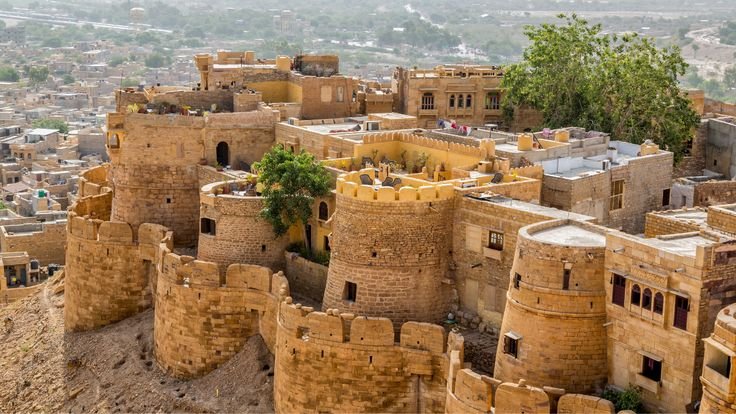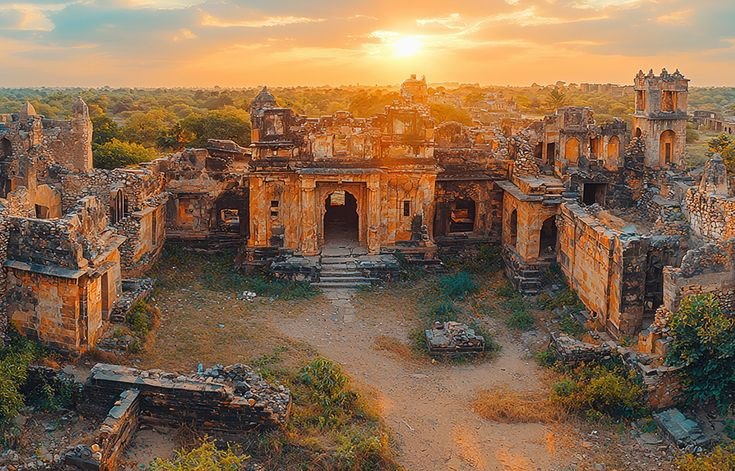The Golden Legacy of Jaisalmer Fort: Exploring Rajasthan’s Living Wonder

A First-Time Visitor’s Guide to Exploring Gadisar Lake
June 26, 2025Towering above the vast expanse of the Thar Desert, Jaisalmer Fort is one of India’s most majestic living forts. Often referred to as the Golden Fort or Sonar Quila, it rises like a sandcastle from the golden dunes of Rajasthan, glowing with history, heritage, and architectural brilliance. Built from golden-yellow sandstone, the fort shines in sunlight, earning its poetic name and captivating visitors from across the globe.
Let’s step inside the walls of the Jaisalmer Fort to uncover its rich legacy, stunning architecture, and everyday life that still thrives within its ramparts.
Table of Contents
The Origins of Grandeur: Jaisalmer Fort History
The history of Jaisalmer Fort dates back to 1156 AD, when it was founded by Rawal Jaisal, a Bhati Rajput ruler, who named it after himself. Perched atop Trikuta Hill, the fort was strategically located to control key trade routes between India, Central Asia, and the Middle East. Over the centuries, it witnessed fierce battles, heroic Rajput tales, and tragic events such as Jauhar—the self-sacrificial act of women during sieges.
Despite these trials, the fort remained resilient. Its massive walls have stood the test of time, witnessing the rise and fall of kingdoms. Today, Jaisalmer Fort represents not just a monument but a living archive of Rajputana pride and spirit.
What is the Real Jaisalmer Fort Name?
While popularly called Jaisalmer Fort, its original name is Sonar Quila, meaning Golden Fort. This nickname became globally recognized after legendary filmmaker Satyajit Ray made it the setting of his famous detective film, Sonar Kella. Since then, the golden glow of the fort has attracted filmmakers, photographers, historians, and curious travelers alike.
Architectural Brilliance: The Fort’s Unique Design
The Jaisalmer Fort is a marvel of Rajput architecture, beautifully fused with Islamic design influences. Built from sandstone, the fort reflects hues of gold during sunrise and sunset. It houses:
- Four Grand Entrances: Akhai Pol, Suraj Pol, Ganesh Pol, and Hawa Pol, each telling its own tale of royal defense and architectural elegance.
- 99 Bastions: The outer walls are reinforced with massive bastions, originally designed for warfare, now serving as scenic viewpoints.
- Jain Temples: These temples, dating back to the 12th century, are known for their stunning stone carvings and spiritual calm.
- Royal Palaces and Courtyards: The former residence of rulers, offering panoramic views of the desert.
- Havelis: Grand homes of wealthy merchants that showcase intricate latticework and stone artistry.
Inside, you’ll find meandering lanes filled with markets, temples, homes, cafés, and everyday life. This makes it one of the very few living forts in India, inhabited by around 3,000 residents.
Jaisalmer Fort Timings: Plan Your Visit Smartly
To truly appreciate the fort’s beauty, planning your visit at the right time is essential. The Jaisalmer Fort timings are from 9:00 AM to 5:00 PM, and it remains open every day. The best time to visit is between October and March, when the desert heat is milder and more pleasant for walking tours.
Jaisalmer Fort Entry Fee and Ticket Price Details
For those planning a visit, understanding the entry charges is helpful. The Jaisalmer Fort entry fee starts from ₹30 for Indian children and ₹50 for Indian adults. For foreign tourists, the price starts from ₹250. If you’re carrying a still camera, the charge is ₹50, and for a video camera, it’s ₹100. Tickets can be purchased at the main entrance and may also include access to select temples and royal buildings inside the fort.
Inside the Fort: A Living Heritage
What makes Jaisalmer Fort Rajasthan so unique is its ongoing legacy. Unlike most historical monuments that serve as tourist sites, this fort is alive. People live here. Markets operate. Schoolchildren walk past centuries-old temples. The fort isn’t just about the past—it’s very much part of the present.
Explore:
- Rooftop Cafés with scenic views
- Handicraft Bazaars selling puppets, silver jewelry, patchwork textiles, and leather goods
- Temples and Stepwells where silence meets history
This blend of old and new offers a deeply immersive experience for any traveler.
Guided Experiences: Enhance Your Fort Visit
To unravel the fort’s deepest stories, hidden corners, and rich symbolism, it is recommended to hire a Tour Operator in Jaisalmer. A knowledgeable local guide can help you explore not just the main attractions but also the secret alleys and historical anecdotes that you might otherwise miss. They often include offbeat spots like nearby havelis, ancient stepwells, and scenic rooftops overlooking the golden city.
Food, Shopping, and Culture: Life Within the Fort
Exploring the Jaisalmer Fort isn’t just about history—it’s a sensory delight. From vibrant shops to flavorful food, every turn offers something memorable.
What to Shop:
- Camel leather accessories
- Colorful patchwork quilts
- Handcrafted puppets and trinkets
- Miniature paintings and antique coins
What to Eat:
Many rooftop eateries serve authentic Rajasthani cuisine. Don’t miss:
- Dal Baati Churma – a traditional trio of baked wheat balls, lentils, and sweet crushed wheat
- Ker Sangri – a tangy desert bean delicacy
- Gatte ki Sabzi – gram flour dumplings in spicy gravy
- Laal Maas – a spicy red mutton curry for meat lovers
With panoramic views of the city, dining inside the fort becomes a cultural affair.
Photography Tips: Frame the Fort’s Golden Beauty
Photographers are drawn to Jaisalmer Fort for its golden hues and intricate details. To capture its charm:
- Golden Hours: Shoot during sunrise or sunset for best lighting.
- Wide-Angle Lens: Perfect for capturing bastions, gates, and city views.
- Macro Shots: Focus on detailed carvings inside temples and havelis.
- Elevated Vantage Points: Try shots from outside the fort, especially near Gadsisar Lake or nearby rooftop cafés.
These perspectives help highlight the architectural and natural harmony that defines Jaisalmer’s charm.
Why Jaisalmer Fort Should Top Your Rajasthan Bucket List
Few destinations in India offer the surreal combination of history, culture, and active community life quite like Jaisalmer Fort Rajasthan. Whether you’re an architecture enthusiast, a heritage traveler, or someone seeking soulful stories beyond the mainstream, the fort promises a deeply enriching experience.
Its walls speak of centuries of stories—of kings and queens, of battles and trade, of resilience and evolution. And yet, it continues to live on, not in silence, but in the vibrant rhythm of daily life.
FAQ’s
Q1. What is Jaisalmer Fort famous for?
Jaisalmer Fort is famous for its golden sandstone glow, stunning Rajput architecture, and being one of the few living forts where people still reside.
Q2. What is the real name of Jaisalmer Fort?
The real name of Jaisalmer Fort is Sonar Quila, meaning “Golden Fort,” built by Rawal Jaisal in 1156 AD.
Q3. What are the timings and entry fees of Jaisalmer Fort?
The fort is open daily from 9:00 AM to 6:00 PM. Entry is free, but some places inside charge between ₹50 to ₹250.
Q4. How much time is required to visit Jaisalmer Fort?
You’ll need around 2 to 3 hours to explore the fort’s temples, palace, havelis, and local shops.



